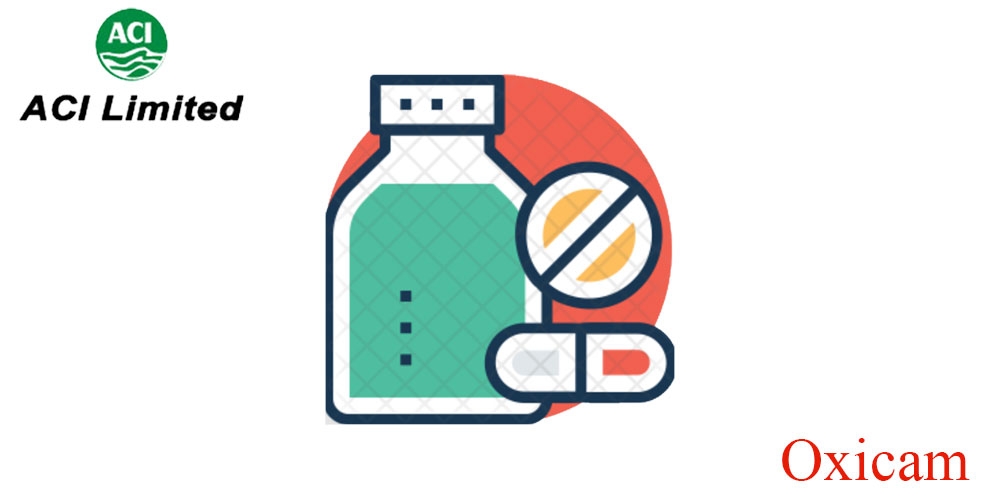ঔষধের বিস্তারিত বা বিকল্প ঔষধ জানতে ঔষধের নাম দিয়ে সার্চ দিন। যেমন- Napa বা Alatrol বা Amodis
Oxicam 20mg
TabletTenoxicam
ACI Pharmaceuticals
Other Strength:
Alternative:
- Mobicam 20mg
- Enocam 20mg
- Tenopain 20mg
- Xten 20mg
- Xicotil 20mg

Oxicam
Description
Oxicam®is the preparation of Tenoxicam; a non-steroidal anti-inflammatory drug (NSAID) with anti-inflammatory, analgesic, antipyretic properties and it also inhibits platelet aggregation. Tenoxicam inhibits prostaglandin biosynthesis and used in the treatment of inflammatory and degenerative disorders of the musculoskeletal system.
Indication
Oxicam®is indicated for the symptomatic treatment of rheumatoid arthritis, osteoarthritis, ankylosing spondylitis, acute gout, and extra-articular inflammations such as tendinitis, bursitis and periarthritis of the shoulders or hips. It is also indicated in musculoskeletal & postoperative pain and in primary dysmenorrhea.
Dosage and Administration
For all indications (except primary dysmenorrhea, post-operative pain and acute gout) the usual recommended dose is 20mg once daily. Oxicam®should be taken at the same time of day, in case of rheumatoid arthritis Oxicam®should be taken at night to relieve the morning stiffness. The recommended dose for primary dysmenorrhea is 20 to 40mg once daily. For post-operative pain the recommended dose is 40mg once daily up to five days and for acute attacks of gout the recommended dose is 40mg once daily for two days followed by 20mg once daily for a further five days. Oxicam®is not recommended for use in patients under 16 years of age.
Pregnancy and Lactation
The safety of Tenoxicam during pregnancy has not been established therefore it should be used with caution during pregnancy and only if the benefit to the mother is greater than the risk of the foetus. There is no information available about the safety of Tenoxicam during breastfeeding therefore it should not be used during lactation.
Side effects
Oxicam®is well tolerated in the recommended doses. The usual side effects are mild and transient gastric, abdominal discomfort, dyspepsia, heartburn, nausea, dizziness, headache, itching, erythema, rash, urticaria, increase in BUN or creatinine, edema and palpitations. In isolated cases GI-perforation, asthma, angioedema and elevated blood pressure may occur.
Contra-indications
Tenoxicam should not be administered to patients with active peptic ulcer or active inflammatory diseases of the gastrointestinal tract. Tenoxicam is contraindicated in patients who have shown hypersensitivity to the drug. It should not be used in patients in whom acute asthmatic attacks, urticaria, rhinitis or other allergic manifestations are precipitated by ASA or other nonsteroidal anti-inflammatory agents. Fatal anaphylactoid reactions have occurred in such individuals. Before anesthesia or surgery, Tenoxicam should not be given
to elderly patients, to patients at risk of renal failure, or to patients with increased risk of bleeding, because of an increased risk of acute renal failure and possibility of impaired haemostasis. Tenoxicam is relatively contraindicated in patients with liver dysfunction.
Precaution
Caution should be exercised in patients have symptoms of gastrointestinal diseases. If peptic ulceration or gastrointestinal bleeding occurs, Tenoxicam should be immediately withdrawn. It is necessary to adequately monitor the patient with increased risk of developing renal failure, impaired renal function in diabetes, hepatic cirrhosis and congestive heart failure. Patients having coagulation disorders or receiving therapy thatinterferes with haemostasis should, however, be carefully observed when treated with Tenoxicam. In women who have difficulty conceiving or are undergoing investigation of infertility, withdrawal of Tenoxicam should be considered.
Drug-interactions
Salicylates increase the clearance and volume of distribution of Tenoxicam by displacing it from protein binding sites. Concurrent treatment with salicylate or other NSAIDs is not recommended because of increased risk of undesirable reactions. Co-administration of Tenoxicam and methotrexate has been associated with reduced renal tubular secretion of methotrexate. As with NSAIDs in general, Tenoxicam should not be administered concurrently with potassium sparing diuretics. Tenoxicam might attenuate the antihypertensive effects of a-adrenergic blockers and ACE-inhibitors. It may also enhance the effect of antidiabetic drug (sulphonylurea group).
Overdosage
Although there is no experience of acute overdosage with Tenoxicam. Overdose should be countered by reducing absorption (eg. gastrolavage and charcoal) and speed up elimination (eg. cholestyramine).
Pharmaceutical Precaution
Store in a cool and dry place. Protect from light.
Presentation
Oxicam®20 mg tablet: A yellow colored, round, film coated tablet.
এই পাতাটি ১১৩ বার দেখা হয়েছে
রাজডক কী?
ফ্রী সদস্য হোন Click Here
ডাক্তার হিসাবে যোগদান করতে Click Here
নার্স / টেকনোলজিস্ট হিসাবে যোগদান করতে Click Here
ফ্রী সদস্য হোন Click Here
ডাক্তার হিসাবে যোগদান করতে Click Here
নার্স / টেকনোলজিস্ট হিসাবে যোগদান করতে Click Here

